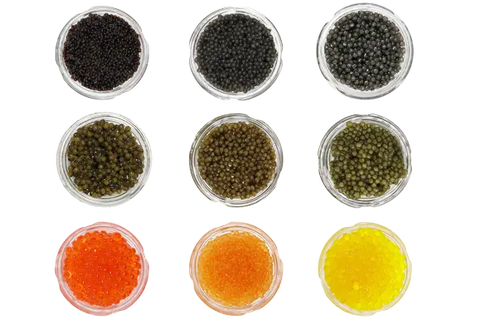Caviar is the unfertilized eggs (roe) of a large fish called the sturgeon, however, most people refer to all fish eggs as caviar. Caviar is a delicacy commonly enjoyed on its own, as a spread, or as a garnish.

Table of Contents
Sturgeon caviar is cured in salt and is typically black, dark grey, or dark brown. Other caviars (known as fish roe or red caviars), such as salmon, trout, lumpfish, tobiko, and masago are typically orange and red. Learn more about the differences between caviar and other fish eggs in this guide.
Check out this fun video to learn what caviar is, how it’s made, and how it’s best enjoyed.
Types of Caviar
The sturgeon fish family (scientific name Acipenseridae) has over 25 species, which originate and live in different parts of the world.
Each species produces unique and distinct eggs that differ in taste, size, and colour. You may have heard of some of the most expensive and popular ones such as Beluga Caviar, Ossetra Caviar, and Sevruga Caviar.
Similarly, other non-sturgeon caviars come from hundreds of different families of fish and vary in size, taste and colour as well.
If you’re curious to learn more about the different types of caviar, check out this guide.
Grading & Labelling System
Caviar is graded on the basis of egg size, egg shape and firmness. A large egg, with a perfectly spherical shape and firm texture will command a top grade.
You may have come across certain labels that say “Imperial”, “Royal”, “Royal Imperial”, “Special Reserve”, “President”, “Tsar”, etc.
These are not part of an industry standard and each producer uses them differently mainly for marketing purposes and product differentiation.
For example, you may find a producer with Classic Beluga ($), Imperial Beluga ($$), and Royal Beluga ($$$). While these are all caviar from the same species (Beluga Sturgeon), the difference will be the egg size, shape, and firmness amongst other less important factors such as colour.
In the end, you must look beyond the marketing labels, find a trusted source, and more importantly, one you can buy from and enjoy consistently.
Caviar Cost
Caviar is notoriously one of the most expensive foods in the world costing well above $3,000 a kilogram.
However, this is only true for real sturgeon caviar. Non-sturgeon caviars such as salmon or masago are quite inexpensive, starting at only a few hundred dollars per kilogram.
In brief, sturgeon caviar is expensive because it takes a long time (over 10 years!) and a lot of effort to produce.
To learn more, check out our Complete Guide to Caviar Prices or read our article on Why Caviar is so Expensive.
Caviar Taste
All roe (sturgeon and non-sturgeon) typically have buttery/creamy, salty, and oceanic flavours. Sturgeon caviars are very rich and buttery with a light touch of salt and complex flavours. Non-sturgeon caviars are commonly less rich with simpler flavour profiles.
If you want to learn more on this topic, read our Caviar Flavour and Taste Guide.
Production
Before sturgeons became an endangered species, caviar was extracted from wild sturgeon in various parts of the world, with the best coming from the cold waters of the Caspian Sea around Russia, Ukraine, and Iran.
Due to overfishing, sturgeons are now a protected species so the vast majority of the product on the market today is farmed. The largest sturgeon farm in the world can be found in:
- Asia (China, Russia)
- Europe (Italy, Spain, France, Poland, Germany, Bulgaria)
- North America (United States, Canada)
Non-sturgeon caviar, on the other hand, comes from smaller, more abundant fish so the majority of this product on the market still comes from wild sources around the world.
Preparation
Once a female fish has matured, the egg sack (ovaries) is extracted as a whole. It is washed for impurities and then gently rubbed against a filtering net to separate the eggs. Once separated, they are rinsed and inspected one last time.
The roe then goes through a salt-curing, aging, and pasteurization process before being packaged and distributed for sale.

Different Names & Spellings
In English, we refer to sturgeon roe and other fish roe as caviar.
If you are travelling abroad or visiting a specialty store with imported products, you may find caviar spelled in the following ways:
- Cavier
- Cabiar
- Caviear
- Cabier
- Kaviar
- Kavier
- Kaviaar
- Kaviare
- Khaviar
- khavyar
- Caviaro
- Havyar
All these different spellings refer to the same product – caviar – they are simply the phonetic spelling from a foreign language such as Persian or Russian.
Sources
- CaviarHub.ca Research
- The Caviar Market – EUMOFA
- Caviar Etymology – Wiktionary


